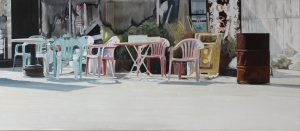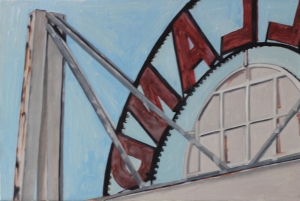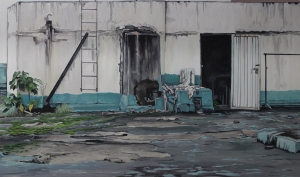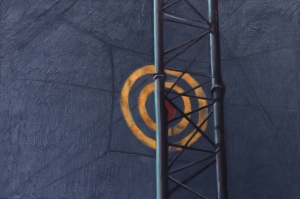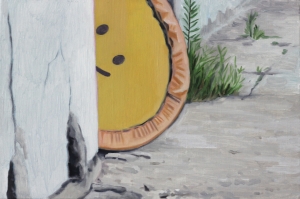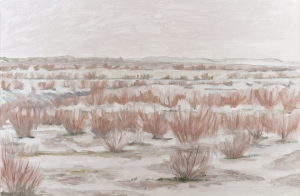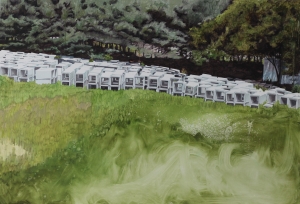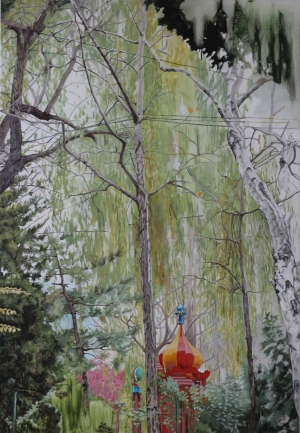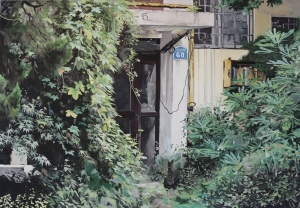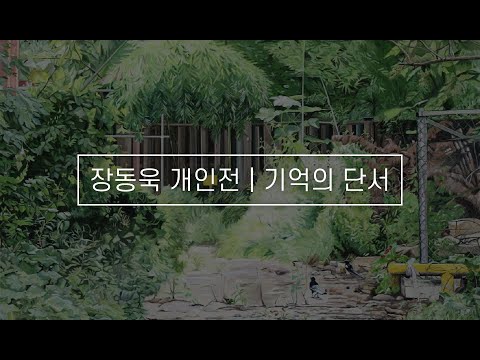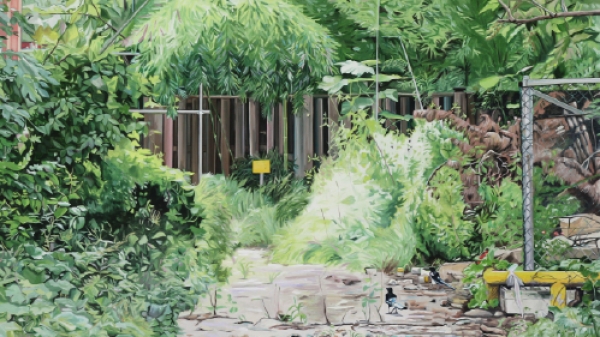전시 EXHIBITION
기억의 단서
삶이 닿아있는 도시에서 목적지를 잃어버린 나는 그 주변을 배회 한다. 지나치는 사람들 틈에서 낯선 도시의 이면을 찾아본다. 그리고 어딘가에 나처럼 이방인이 되어 소멸되고 있는 기억을 담아낸다.
#1 사물은 출처를 알 수 없이 수집된다, 그리고 그 대상을 인지하며 기억을 더듬어 본다. 마치 어딘가 남아있을 기억을 단서처럼 관찰의 시간을 갖는다. 내게 사물의 특수성은 군부대에서 보았던 과거의 잔해들이었다. 부식된 철모와 버려진 탄피들은 의도하지 않은 경험에서 인지하였고 끊임없이 학습하였던 남북 분단의 점이지역에 남겨진 것들이다. 무분별하게 노출된 사물들에 남겨진 기억에 관심을 갖게 되며 쓰임을 다하거나 남겨진 사물들의 기억을 수집한다.
#2 내게 담겨진 도시의 풍경은 마치 덩그러니 놓여 있는 모습들이다. 사람의 손길이 닿았던 순간들이 풍경 안에 흩어져 있다. 기억의 단서처럼 분산된 사물과 구조물들 사이로 식물들이 올라와 있다. 무분별하게 뒤엉켜 자라나는 식물은 시간을 거스른 야생의 증식과도 같이 기억이 파편화되어 남아있다. 이런 공간은 어딘가 모르게 나와 닮아있다고 단정 지어보며 유년기의 기억을 거스른다. 나의 유년기 고향은 성수기가 존재하는 지역으로 그곳의 성수기는 많은 사람이 오갔으며 밤에도 도시의 야경처럼 생기가 넘쳤다. 작았지만 놀이동산이었으며 커다란 리조트와 몇몇 건물들도 들어서 있었다. 마치 영원할 것 같았다. 어느덧 고향을 떠나 도시에서 생활을 하며 이곳저곳을 전전한다.
캔버스에 그려지는 풍경은 이런 곳이다. 잊혀졌지만 아직 남아있는 것들이며 기억의 레이어가 쌓여있는 곳 그리고 시간의 흐름에 따라 횡적으로 자라난 식물들이 마치 그 공간에 기억이 발화 하듯 증식한 공간이다.
-
《기억의 단서》
홍예슬(대전시립미술관 학예연구사)
단서 1. 내밀한 이야기
올해 우연히 장동욱 작가의 포트폴리오를 접하게 되었다. 현실에 있을 법한 장소지만 어딘가 비현실적인 느낌을 주는 나른함이 기억에 남았다. 아티스트 레지던시 테미에서 그의 평론 의뢰가 왔을 때 그 모호함이 무엇인지 확인할 수 있겠구나 싶었다. 그렇게 방문한 장동욱의 작업실 캔버스에 자리하는 대상은 특별하게 화려하거나 요란하지 않았다. 2017년까지 진행되었던 〈오브제〉, 〈무제〉로 명명된 시리즈는 흔히 볼 수 있는 사물들을 소재로 삼고 있다. 수집한 사물들은 주로 옥수수 통조림, 웨하스 과자의 비닐, 비누 케이스 등 일상에서 볼 수 있는 익숙한 대상들이다. 하지만 단순히 대상을 재현하는데 그치지 않고, 사물이 수집된 경로 등의 단편적인 기억으로 의미를 재구성하는 데 그 의미를 찾을 수 있다. 지금은 세상을 떠난 지인을 추모하는 방식으로 오랜 시간 동안 그가 다닌 음식점에서 수집했던 성냥갑을 그리는 등 각 사물에는 각 사물마다 고유의 이야기가 존재한다. 색감과 표면적 질감을 섬세하게 표현된 그의 정물을 보고 있으면 누군가의 어떤 이야기가 담겨 있을지 궁금증을 유발한다. 작가는 이처럼 내밀한 이야기를 캔버스로 옮긴다. 그의 작업은 우리가 외면했거나 미처 눈여겨보지 않았던 사물과 공간을 환기시킨다. 그리고 이러한 내밀한 이야기들은 작가의 유년 시절에 많은 부분을 빚지고 있다. 2017년부터 그의 기억들은 풍경으로 확장되었다. 그가 그리는 풍경은 주로 거주지 주변이다. 대천, 인천, 서울, 대전 등의 장소에 머물렀던 기억들을 연속적으로 나열하기도 하고 그 기억을 조합하여 새로운 풍경을 만들어내기도 한다.
단서 2. 절정이 지나간 자리
장동욱은 바닷가 근처 관광지였던 충남 대천에서 나고 자랐다. 그의 작업들은 모두 유년기에 마주쳤던 풍경에서부터 시작된다. 새로운 거주지의 낯선 환경에서 채집된 사물들과 풍경은 과거의 기억들과 교차되며 캔버스에 옮겨진다. 주로 일상 속에서 배경으로만 생각하는 아파트 단지 내의 놀이터, 공장 지대, 거주지와 일터에서 마주하던 풍경 등 지나치기 쉬운 주변부에 대한 미시적인 감각을 지속한다. 이는 그가 태어난 장소와 무관하지 않을 것이다. 그의 고향인 대천은 과거 전국에서 몰려드는 관광객들로 문전성시를 이루던 서해안의 최대 관광지였다. 하지만 현재, 대천은 과거의 영광은 뒤로 한 채 새로운 도약을 시도하는 곳이 되었다. 그렇기 때문일까 작가는 절정이 지나갔거나 절정에 아직 도래하지 않은 평범한 사물과 장소들에 마음을 쏟는다. 작가는 대상을 지그시 바라보는 것으로 작업의 시작점을 삼는 그는 주변을 관찰하면서 과거에 경험한 풍경과 교차점을 찾는다. 주로 과거에 마주쳤던 풍경들과 유사하게 느껴진 색감과 불안정한 요소들에 영감을 받는다. 지금까지 작가가 경험했던 거주지 주변엔 과거 급속한 도시 발전의 흔적들이 남아 있었다. 이러한 흔적들은 작가의 유년기 기억을 공통적으로 건드리고 있다. 결과적으로 유년기의 잠재적인 기억들이 현재 거주하는 거주지 주변의 풍경으로 확장하여 하나의 지표로 작용한다. 〈수영장〉(2018)은 대학원 과정을 위해 거주한 마포구청 인근의 야외 수영장을 담은 것이다. 당시 주변은 공사가 진행중이였기에 공사 현장 특유의 불안정한 모습을 포착하게 되었다. 이 지점에 그는 새로운 구조물이 설치되고 사라지던 어린 시절 대천의 풍경의 잔재와 마주하게 되었다. 〈랜드〉(2019)에서 그 놀이동산의 구조물을 확인할 수 있다. 이처럼 작가의 눈에 감기는 풍경은 주로 절정이 지나간 자리에 남겨진 공간들이다. 우리가 쉽게 지나치는 아파트 단지 내에 있는 놀이터 풍경을 담은 〈교차지점〉(2019) 등도 그렇다. 그는 테미 레지던시에 머무르면서 대전에서 영감을 주는 장소를 스터디 해왔다. 주변에서 추천한 소제동 등을 방문했지만 딱히 마음에 끌리지는 않았다고 한다. 지금의 소제동은 레스토랑, 카페가 들어서는 새로운 상업지구로 탈바꿈되고 있기 때문일 것이다. 대신 그는 우연히 문화동 외곽을 발견했다. 메인 작업이라고 볼 수 있는 〈자생(自生)식물〉(2019)과 〈증식하는 풍경〉(2019)은 문화동의 어느 주거 지역을 그린 것이다. 이 풍경을 마주했을 때 작가는 유년 시절에 살았던 집이나 근처의 장면들이 강렬하게 떠올랐다고 한다. 귀화식물인 환삼 덩굴 등의 풀들은 제멋대로 난잡하게 자라 있다. 마구잡이로 증식되는 풀들은 과거의 기억들이 증식되는 과정들과 유사하다. 즉 녹색의 풀들은 작가의 기억이 작용하는 매커니즘이자 메타포가 된다. 〈스마일〉(2019)은 문화동의 재개발 지역에서 포착한 것이다. 주거지역의 재개발은 오래된 건물을 부수고 새 건물을 올리는 행위의 단순함을 의미하지 않는다. 오랜 시간동안 자리해온 건물에는 그 풍경이 견뎌내 온 시공간 또한 함축되어 있다. 재개발이라는 특수 상황은 순식간에 혹은 매일 조금씩 견고하게 자리했던 대상들을 사라지게 한다. 작가는 소멸되는 풍경의 끊임없는 변화상에 대해서도 마음을 쏟는다. 동시에 유년의 기억과 현재 발견한 장소와의 복합적인 상호작용에 초점을 맞추며 기억을 발췌한다.
단서 3. 현실과 비현실의 사이
존재하는 장소를 그렸음에도 불구하고 그가 표현하는 장소는 실재를 재현하지 않는다. 〈the place where at〉)(2018)은 대천 인근 바닷가 풍경의 일부분과 거주지 주변에서 포착한 담벼락을 중첩시켜 작업한 것이다. 그려지는 대상의 색감과 이미지의 삭제, 흘러내리는 물감의 우연한 효과들은 그의 작업이 비현실적인 어딘가가 묘한 느낌을 주는 이유이다. 〈statue〉(2018)에서 맥아더 장군의 동상은 얼굴이 그려져 있지 않다. 주변의 상징적인 건축물과 기념비적인 동상들 또한 특정한 장소와 관계를 맺으면 작업이 진행되기보단 전적으로 그 대상이 주는 개인의 감정과 기억에 초점을 맞춰 그려진다. 위용 있는 맥아더 장군의 모습보다는 일상에서 마주친 노인의 시선이 중심이다. 그의 작업에서 유일하게 등장하는 인물이기도 한데, 이는 한국전쟁 참전용사였던 그의 할아버지와 교차되는 기억이다. 그리고 주변의 풍경 또한 구체적이지 않고 해체된 형상으로 명확하지 않은 불안정한 기억의 잔재를 표현한다. 이러한 애매모호한 기억의 조합들은 〈동인천〉(2018)에서도 드러난다. 플라스틱 의자와 식탁, 드럼통은 사실적으로 묘사되었지만 이 두 조합은 조화롭지 못하며 노란 표지판 같은 플라스틱 덩어리 또한 부조화스럽다. 이는 단순한 재현을 넘어서 기억의 집합체로 기능하기 위함이다. 이로 인해 사실적인 그 장소만의 고유한 분위기를 잃지 않으면서도 애매모호한 기억의 조합이 포착된다. 그의 작업은 누구나 겪었을 보편적인 기억을 불러낸다. 기억은 그의 작업을 독해하는 중요한 요소로 작용하며, 보는 이의 내밀한 기억들을 건드린다.
《기억의 단서》로 장동욱 찾기
과거의 기억을 담은 거주지 주변의 풍경은 유실된 과거의 풍경들을 포함하면서도 현재 새로운 장소에서 맺는 관계성을 동시에 내포한다. 작가의 내밀한 기억들과 상호작용을 이루는 거주지 풍경들은 실재하고 있는 대상이기에 현재의 나를 기록하는 과정이 되기도 한다. 이러한 과정에서 풍경은 현시대를 살아가고 있는 나와 과거로부터 흘러온 풍경의 접점이며 현재의 나를 찾기 위해, 나의 기억과 유사한 대상들을 찾아 그 안에서 새로운 의미를 도출해내는 것이다. 기억에 의존하는 풍경은 끊임없이 움직이며 흐름 속에서 변화하는데, 그렇기 때문에 완성된 그림에서 계속해서 수정된다. 그 과정에서 기억과는 또 다른 풍경으로 인도하는 기억의 교집합적인 풍경이 탄생하게 된다. 그는 자신이 현재 바라보는 풍경들도 시간이 흐르면 또다시 유실되거나 변모할 것에 대한 불안감을 갖고 있다. 이는 계속되는 거주지의 이동과 불안정성과 무관하지 않다. 작가는 작업을 위해 거주지를 계속 이동했다. 일반적으로 레지던시는 낯선 곳에서 일정 기간 거주하는 유목과 이동의 형태를 취한다. 기간이 6개월에서 1년으로 정해져 있는 레지던시 기간이 종료되면 작가들은 또 다른 작업공간인 레지던시를 찾아 이주해야만 한다. 이는 1년 이상의 장기적인 계획을 세울 수 없는 현실을 뜻하기도 한다. 어딘가에서 산다는 것을 뜻하는 거주는 삶과 맞닿아있는 필수조건이다. 이러한 거주지를 항상 이주할 수밖에 없는 현실은 한 인간 개체로서는 큰 불안감을 이고 사는 것이다. 이는 현시대를 살아가는 작가들이라면 공통적인으로 겪는 숙명과도 같다. 이러한 작가로서의 삶을 받아들이기 위해 그는 새로운 곳을 탐색한다. 그리고 그만의 내밀한 기억과 교집합되는 기억들을 발췌하고 기록하며 안정감을 찾는다. 이는 불안함을 회피하기 위한 방법이자 현재의 장동욱을 찾아가는 방법이다.
《Clues to Memory》
Hong Ye-seul (Curator, Daejeon Museum of Art)
Clue 1. Private stories
I came upon Jang DongWook’s portfolio by chance this year. The sites, which may well exist in reality, somehow felt unreal, leaving a certain sense of languidness in my memory. When I got a request from the Artist Residency TEMI to write his review, I thought that I was given a chance to identify what the vagueness was. So, I visited Jang’s studio, and the subjects on his canvases were not particularly fancy nor impressive. The ‘Objects’ and ‘Untitled’ series he pursued until 2017 used objects commonly seen around us. He collected familiar things such as corn cans, cookie packages and soap cases. He didn’t stop at merely recreating them, however, and reconstructed the meanings based on fragmented memories on how the items were collected, etc. Each item has its own story, as the matchbox he collected from a diner where his deceased friend had frequented, to remember him. His objects with delicately expressed colors and surface texture arouse viewers’ curiosity about their stories. As such, the artist delivers these private stories onto the canvas. His works evoke things and spaces that we have avoided or failed to pay attention to. And these private stories are mostly from the artist’s childhood. Since 2017, his memories have been extended to landscapes. His landscapes are mostly those around his places of dwelling. He either enumerates his memories of living in places including Daecheon, Incheon, Seoul and Daejeon successively, or creates new landscapes by combining the memories.
Clue 2. Places that have passed their primes
Jang DongWook was born and raised in Daecheon, Chungcheongnam-do, a tourist town famous for its sea. All of his works start from views that he encountered as a child. Objects and sceneries collected from strange environments in new sites of dwelling are mingled with past memories and transferred to the canvas. Microscopic perception is maintained of peripheral landscapes such as those of playground in the apartment complex, industrial quarters, neighborhood and workplace, which we usually consider as daily backgrounds and overlook. This may not be unrelated to his birthplace. Daecheon used to be the biggest tourist attraction on the west coast flooded by visitors from around the country. However, now it is preparing for a new takeoff, with its past glory remaining only as a memory. Maybe that’s why the artist put his heart into plain objects and places that have passed or have not reached their primes. He starts his work with quiet observation of surroundings, and looks for connections to sceneries that he experienced in the past. He is mainly inspired by colors and unstable factors that strike him as similar to the views that he came across in the past. He has witnessed traces of rapid urban development in all the surroundings of his neighborhoods. These traces drive him back to his childhood memories. As a result, the dormant memories from the childhood are extended to the landscapes of his current neighborhood and act as indicators. Swimming Pool (2018) shows an outdoor swimming pool near the Mapo-gu Office area, where he lived as a graduate student. There was construction going on in the area at the time, so what he captured was an unstable scene typical of construction sites. This is the point that brought him to face the remains of the childhood scenes of Daecheon, where new structures continuously rose and disappeared. In Land (2019), viewers can see the structures at the amusement park. Likewise, the views that catch the artist’s attention are usually the spaces that have passed their primes. The same is true with Intersection Point(2019), which presents a playground in an apartment complex that we just pass by. While staying at TEMI, he has studied places in Daejeon that inspire him. He visited sites recommended by others, including Soje-dong, but didn’t find them interesting. It may be because Soje-dong is in the process of being transformed into a new commercial district full of restaurants and cafes. Instead, he was attracted to the outskirts of Munhwa-dong. Wild Plants (2019) and Scene of Proliferation (2019), which can be seen as main pieces for the exhibition, describes a certain residential district in Munhwa-dong. When he saw the scenery, he was strongly reminded of his childhood house and surrounding views. Plants including naturalized Japanese hops have grown in disorder. The process of plants spreading indiscriminately is similar to the process in which past memories proliferate. The green plants become the mechanism, in which his memories work, and metaphor. Smile (2019) is based on what caught his eye in a redevelopment zone in Munhwa-dong. Redevelopment of a residential area is not limited to the simple tasks of demolishing old buildings and constructing new ones. Old buildings are indwelled with the space and time the sceneries have endured for a long time. The particular situation of redevelopment banishes the objects that have been solidly established in an instant or bit by bit. The artist also takes notice of constant changes in the disappearing scenes. At the same time, he extracts memories by focusing on the complex interactions between his childhood memories and the newly-found places.
Clue 3. Between reality and unreality
Although he drew places that existed, those that he shows do not recreate reality. The Place Where At (2018) was created by overlapping a part of the coastal scenery near Daecheon and walls he found in his neighborhood. Omission of colors and images of the objects, as well as accidental effects of trickling paints give a certain unrealistic and peculiar feeling. In Statue (2018), the statue of General MacArthur does not have its face. Symbolic buildings and monumental statues surrounding it are described entirely focused on private feelings and memories generated from the objects, rather than their relationships with a specific place. The work is more centered on the eyes of an old man encountered accidentally rather than the dignified look of General MacArthur. He is the only person present in his paintings, and brings up the memory of his grandfather, who was a Korean War veteran. The surrounding scenery also expresses the remains of unclear and unstable memories through indistinct and deconstructed shapes. Such combinations of vague and obscure memories appear in Dongincheon (2018), too. Plastic chairs, tables and a barrel are painted realistically. But the combination is not harmonious, with the yellow plastic mass that looks like a signboard especially standing out. It is an attempt to be more than mere recreation and to function as an assembly of memories. This way, the combination of vague memories, while maintaining the realistic and distinct mood of the place, is captured. His works stir up universal memories that anyone must have had. Memory is an essential element for interpreting his works, which evoke the private memories of viewers.
Finding Jang DongWook using “clues to memories”
The landscapes around his neighborhood, imbued with past memories, incorporate both the lost sceneries of the past and the relationships presently being built in new places. The neighboring landscapes interacting with the artist’s private memories, as objects existing in reality, form the process in which he records his present self. In this process, the sceneries constitute the point of contact between the artist living in the contemporary society and scenes that have flown from the past; and he keeps on looking for objects similar to his memories and find new meanings from them in an attempt to find his present self. Sceneries that depend on memories move constantly and change in the flow, and this is why they continue to be revised in the completed paintings. Through the process, sceneries representing the intersections of memories that lead to scenes distinguished from the memories are created. The artist is anxious that the scenes he is watching in the present may disappear or change in time. This isn’t unrelated to his unending changes in places of sojourn and instability. His profession has driven him to keep moving. In general, residency takes the form of nomadism and movements after a certain period of residence in strange places. Artists participate in residency for six to 12 months and then must search for and migrate to other institutions. This suggests that they cannot set up long-term plans for over a year. Residency, which means to live in a certain place, is a prerequisite for life. A reality in which one should always move to new residencies involve substantial anxiety. It appears to be the destiny commonly shared by contemporary artists. Jang explores new places to accept this way of life as an artist. In doing so, he extracts memories intersecting with his own private memories and finds security. This is a means to avoid anxiety and find the Jang DongWook of the present.
- 기간
- 2019-11-21 ~ 2019-12-2
- 관련행사






